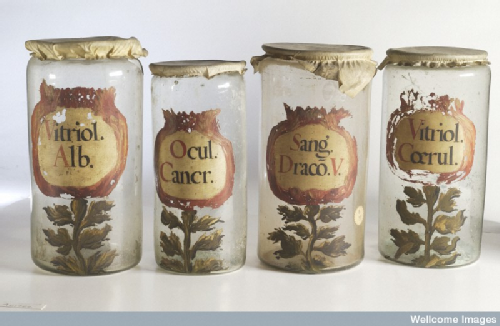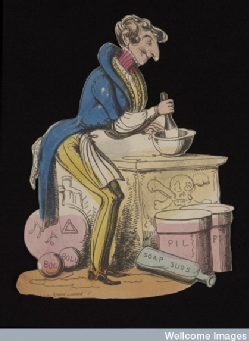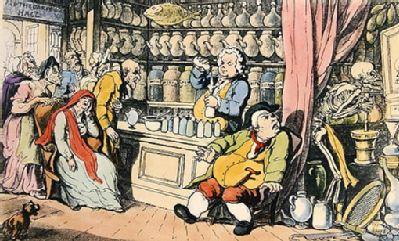Apothecaries in Early Modern Britain - Alun Withey
|
The pages of early modern medical remedy collections commonly contain thousands of ingredients, from common plants and herbs to exotic foreign spices, specially prepared waters and syrups and even animal parts! Most households probably held small stores of ingredients and were able to collect others, either from their own gardens or local vicinity. But it is important to remember that medicines and medical ingredients were also available from a wide range of both medical and non-medical shops all across the country. The numbers of requisite ingredients alone suggest that the demand for medicines must surely have been great and, in response, even shopkeepers in rural villages kept stocks of herbs, spices and sometimes compound remedies such as plague water or hippocras. But the main source of specialised medicines and ingredients was the apothecary – the early modern version of the chemist.
Image 1 - Apothecary jars, used to store a variety of medicines (Courtesy of Wellcome Images) In the seventeenth and eighteenth centuries, most towns and even many villages could boast an apothecary’s shop. Contemporaries viewed medicine in terms of a hierarchical pyramid, with physicians sitting at the top, followed by surgeons and apothecaries on the lower levels. In reality, however, these boundaries were extremely flexible. In theory, physicians treated and surgeons operated, but neither dispensed medicine. But in practice however, apothecaries were multi-functional: they sold medical ingredients, often prepared or created their own preparations for a range of conditions and, although banned from actually treating patients by law, many also acted as medical practitioners. In fact, many physicians and surgeons also supplemented their incomes by running apothecary businesses as a potentially lucrative sideline. Although apothecaries were most often men, there was no official barrier to women dispensing medicine, and there are many examples of female apothecary shops in this period.
Image 2 - 18th Century engraving of an apothecary using a pestle and mortar (Courtesy of Wellcome Images) The apothecary’s shop was an intriguing mixture of function and spectacle, designed both to encourage the customer to buy, but also to reinforce the specialist knowledge of the apothecary. On entering a typical shop, the customer would have been confronted by shelves containing rows of glass and ceramic jars, each with a bewildering array of coloured oils, waters and preparations. Boxes and parcels would be stacked on the floor, while labelled draws contained strangely-named ingredients. In London shops, exotica such as stuffed crocodiles might even be found as a way of adding to the mystique of the apothecary’s art. Business would have been conducted across a wooden desk or counter, upon which might sit scales, a pestle and mortar, the tools of the apothecary. In one corner of the shop might be found a chair upon which the customer might sit while a few ounces of his blood were discharged as a means to ‘spring clean’ his body and get rid of bad humours.
Image 3- ‘Death and the Apothecary or the Quack Doctor’ – by R. Ackermann, 1815-17 Apothecaries sold a wide range of medical goods, from basic herbs and ingredients to expensive chemical medicines. Especially in larger towns such as London, they also acted as agents for the burgeoning market in proprietary, ‘quack’ medicines, such as Daffy’s Elixir and Dr Stephen’s Water. As such, apothecaries were vital components in the early modern market for medicines, providing the raw materials to fuel the ever-growing economy of medical remedies. |
|



